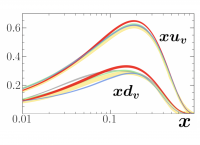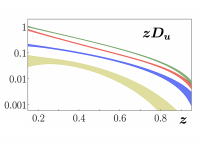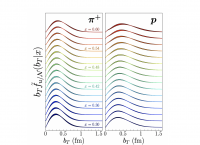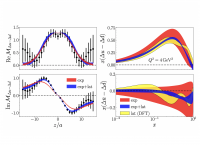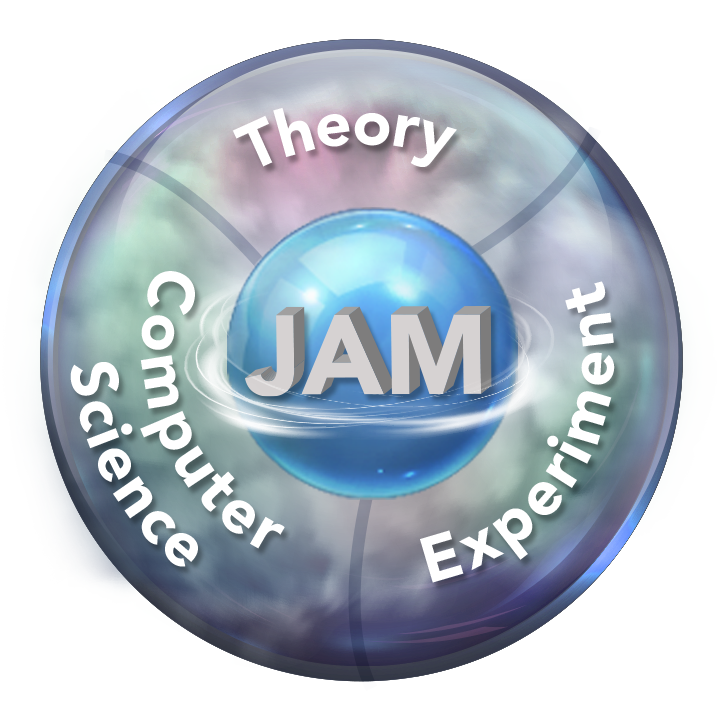
The Jefferson Lab Angular Momentum (JAM) Collaboration is an enterprise involving theorists, experimentalists, and computer scientists from the Jefferson Lab community using QCD to study the internal quark and gluon structure of hadrons and nuclei. Experimental data from high-energy scattering processes are analyzed using modern Monte Carlo techniques and state-of-the-art uncertainty quantification to simultaneously extract various quantum correlation functions, such as parton distribution functions (PDFs), fragmentation functions (FFs), transverse momentum dependent (TMD) distributions, and generalized parton distributions (GPDs). Inclusion of lattice QCD data and machine learning algorithms are being explored to potentially expand the reach and efficacy of JAM analyses and our understanding of hadron structure in QCD.
Latest News
- TRANSVERSITY DISTRIBUTIONS AND NUCLEON TENSOR CHARGES FROM DIHADRON PRODUCTION
A new global QCD analysis includes a comprehensive set of data in electron-positron annihilation, semi-inclusive deep-inelastic scattering, and proton-proton collisions, from which they extract simultaneously the transversity distributions of the nucleon and π+ π- dihadron fragmentation functions. Known theoretical constraints on transversity, namely, its small-x asymptotic behavior and the Soffer bound, are incorporated in the fit. It is shown that lattice-QCD results for the tensor charges can be successfully included in the analysis, resolving the previously reported incompatibility between the tensor charges extracted from dihadron production data and lattice QCD. Agreement is also find with results for the transversity and tensor charges obtained from measurements on single-hadron production. The work demonstrates for the first time the universal nature of all available information for the transversity distributions and the tensor charges of the nucleon.
- RESOLUTION OF THE SIGN OF GLUON POLARIZATION IN THE PROTON
Recently the possible existence of negative gluon helicity, Δg, has been observed to be compatible with current empirical constraints, including from jet production in polarized proton-proton collisions at RHIC, and lattice QCD data on polarized gluon Ioffe time distributions. A new global analysis of polarized parton distributions in the proton was performed with new constraints from the high-x region of deep-inelastic scattering. A dramatic reduction in the quality of the fit for the negative Δg replicas compared to those with positive Δg suggest that the negative Δg solution cannot simultaneously account for high-x polarized DIS data along with lattice and polarized jet data.
- DARK PHOTONS AND GLOBAL QCD ANALYSIS
A new global QCD analysis has been performed by the JAM Collaboration and researchers from the University of Adelaide, including a coupling to a dark photon that augments the standard model electroweak coupling via kinetic mixing with the hypercharge B boson. Including the most recent measurement of the anomalous magnetic moment of the muon as a constraint, the analysis finds a significant reduction in the combined χ2, favoring the inclusion of a dark photon, with a statistical significance in excess of 8σ, and with improvements in the theoretical predictions spread across a wide range of kinematics. The best fit yields a value of g-2 which significantly reduces the disagreement with the latest experimental determination, with best fit values of 4.2 - 6.2 GeV for the dark photon mass and a mixing parameter of order 0.1.
- TOMOGRAPHY OF PIONS AND PROTONS VIA TRANSVERSE MOMENTUM DEPENDENT DISTRIBUTIONS
A new paper reports the first simultaneous extraction of parton collinear and transverse degrees of freedom from Drell-Yan data in order to compare the transverse momentum dependent (TMD) parton distribution functions (PDFs) of the pion and proton. The analysis demonstrates that the transverse separation of the quark field encoded in TMDs of the pion is more than 5σ smaller than that of the proton. Additionally, it finds that the transverse separation of the quark field decreases as its longitudinal momentum fraction decreases, and observes clear evidence for a transverse nuclear EMC effect.
- GLUON POLARIZATION WITH HIGH-TRANSVERSE MOMENTUM HADRONS IN SIDIS
A recent global QCD analysis of jet production and other polarized scattering data found the presence of negative solutions for the gluon helicity distribution in the proton, Δg, along with the traditional Δg > 0 solutions. A new paper considers polarized semi-inclusive deep-inelastic scattering for hadrons produced with large transverse momentum as a means of constraining the dependence of Δg on the parton momentum fraction. Focusing on the double longitudinal spin asymmetry, the paper identifies the kinematics relevant for future experiments at Jefferson Lab and the Electron-Ion Collider, which are particularly sensitive to the polarized gluon channel and could discriminate between the different Δg behaviors.
- MIRROR NUCLEI SHED MIGHT ON MYSTERIOUS EMC EFFECT
Physics World features the recent JAM paper on a Monte Carlo global QCD analysis of unpolarized PDFs, including for the first time constraints from ratios of 3He to 3H structure functions recently obtained by the MARATHON experiment at Jefferson Lab. The simultaneous analysis of nucleon PDFs and nuclear effects in A=2 and A=3 nuclei reveals the first indication for an isovector nuclear EMC effect in light nuclei. While the MARATHON data yield relatively weak constraints on the neutron to proton structure function ratio and the d/u PDF ratio, they suggest a strongly enhanced nuclear effect on the d quark PDF in the bound proton.
- PION PARTON DISTRIBUTIONS: COMPLEMENTARITY OF EXPERIMENTAL AND LATTICE QCD DATA
A new paper by the JAM and HadStruc collaborations reports the extraction of the pion parton distribution functions (PDFs) in a Monte Carlo global Quantum Chromodynamics (QCD) analysis of experimental data together with pseudo-PDFs and matrix elements generated from lattice QCD. By including both experimental and lattice QCD data, the analysis rigorously quantifies both the uncertainties of the pion PDFs and systematic effects intrinsic to the lattice QCD observables. Consistent with recent phenomenological determinations, the behavior of the valence quark distribution of the pion at large momentum fraction is found to be ∼(1−x)β, where β=1.0-1.2.
- POLARIZED ANTIMATTER IN THE PROTON FROM GLOBAL QCD ANALYSIS
A new global QCD analysis of spin-dependent PDFs has been performed that includes the latest W-boson production data from polarized proton-proton collisions. These data allow the first data-driven extraction of a nonzero polarized light antiquark asymmetry, Δu̅ - Δd̅, with minimal theoretical assumptions. The analysis simultaneously extracts polarized PDFs, unpolarized PDFs, and pion and kaon FFs, allowing a self-consistent set of antiquark polarization ratios Δu̅ / u̅ and Δd̅ / d̅ to be determined.
- KINEMATIC REGIME ESTIMATION IN SEMI-INCLUSIVE DIS
A new phenomenological tool has been developed to guide the analysis and interpretation of semi-inclusive deep-inelastic scattering (SIDIS) measurements. The new tool, referred to as “affinity”, helps to visualize and quantify the proximity of any experimental kinematic bin to a particular hadron production region, such as that associated with TMD factorization. As a first application, the affinity estimator has been used to analyze existing HERMES and COMPASS data, as well as expected SIDIS data from Jefferson Lab and the future Electron-Ion Collider.
- HOW WELL DO WE KNOW THE GLUON POLARIZATION IN THE PROTON?
A new JAM paper reports the first simultaneous global QCD analysis of spin-averaged and spin-dependent PDFs, including jet production data from unpolarized and polarized hadron collisions. The paper critically assesses the impact of SU(3) flavor symmetry and PDF positivity assumptions on the quark and gluon helicity PDFs and finds strong bias from these, particularly on the gluon polarization. The simultaneous analysis allows for the first time extraction of individual helicity-aligned and antialigned PDFs with a consistent treatment of uncertainties.
- EXTRACTION OF SEA QUARK ASYMMETRY WITH SEAQUEST AND STAR DATA
A global QCD analysis of unpolarized parton distributions was performed, including new W-lepton production data from the STAR Collaboration at RHIC and Drell-Yan di-muon data from the SeaQuest experiment. The impact of these two new measurements on the light antiquark sea in the proton, and the antidown-antiup asymmetry in particular, was assessed. The SeaQuest data were found to significantly reduce the uncertainty on the antidown/antiup ratio at large parton momentum fractions, strongly favoring an enhanced antidown sea, in general agreement with model calculations based on chiral symmetry breaking in QCD.
Parton distribution functions describe the collinear momentum distributions of quarks, antiquarks, and gluons inside hadrons.
| Unpolarized PDFs | Helicity PDFs | Transversity PDFs | Pion PDFs | Nuclear effects |
Fragmentation functions describe the process of the hadronization of a scattered parton into a detected hadron in the final state of a reaction.
Transverse momentum dependence of partons in the hadron are described through TMD factorization, and parametrized via TMD PDFs and TMD FFs.
Experimental data coupled with lattice QCD simulations can have impact on some nonpertubative distributions.
For further information about JAM, contact JAM@jlab.org



